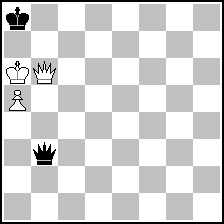|
| Page: [Previous] [Next] 1 2 3 |
| (1) Posted by Hauke Reddmann [Wednesday, Sep 30, 2009 15:56] |
Onemovers?
I just ran into a matrix that possibly might be shown best
as onemover (with some sort of twinning, I guess).
a) Why don't we have a section for 1#? :-)
b) Does anybody know an interesting 1#, NO fairy conditions?
(This also includes the well-known "White to move and NOT to #1"!)
After all, dual avoidance in the mating move is a legit 2# theme,
so maybe this could also stand alone.
Hauke
|
|
| (2) Posted by Steven Dowd [Wednesday, Sep 30, 2009 16:17] |
Hauke, I am not sure what you are trying to show, but isn't h#1 usually accepted as the way to show #2 effects that can't be fully shown in a #2?
|
|
| (3) Posted by Michael McDowell [Wednesday, Sep 30, 2009 16:40] |
There was a Quick Composing Tourney at the Turku WCCC in 1995 where the requirement was “Mate in 1”.
This was one entry, extending an old Dawson idea to both colours:
G.D.Lee, M.McDowell, A.J.Mestel & J.Quah
QCT, Turku 1995
 (= 13+12 ) (= 13+12 )
White mates in 1. Remove the mating piece then mate in 1 again. Continue until no White mate is possible then Black mates in 1. Remove the mating piece and mate in 1 again. Continue until no mate is possible.
16 mates altogether.
|
|
| (4) Posted by Joost de Heer [Wednesday, Sep 30, 2009 17:22]; edited by Joost de Heer [09-10-01] |
Lots of interesting retro compositions in which '#1' really is a way of asking 'who has the move?'
And a letter problem:
M. Brada
 (= 11+5 ) (= 11+5 )
#1
a)  g1->b1 g1->b1
b)  c1->h1 c1->h1
a) 1. Sd2?(A) illegal 0...Rxf3(a)/Rxd3(b) 1. Sf2(B)/Qxe2(C)#
b) 1. Sf2?(B) illegal 0...Rxf3(a)/Rxd3(b) 1. Qxe2(C)/Sd2(A)#
H.H. Schmidt
 (= 3+2 ) (= 3+2 )
a) #1 b) =1 c) s#1 d) s=1
|
|
| (5) Posted by Kevin Begley [Thursday, Oct 1, 2009 07:39] |
to Michael & crew,
Lovely -- each twin is nothing but one simple key, yet together, more fun than chopsticks.
|
|
| (6) Posted by Hauke Reddmann [Thursday, Oct 1, 2009 16:02] |
Neat examples.
(BTW, the Schmidt I could do as Duplex. With a bit more pieces, of course.
http://www.bambam42.de/problem/problem3.html, find f 98/1990 (Nr.6003))
Hauke
|
|
| (7) Posted by Branislav Djurašević [Thursday, Oct 1, 2009 19:53]; edited by Branislav Djurašević [09-10-01] |
For comparassion my own, also in miniature, one more twin.
B.Djurasevic
Mat 1979
 (= 2+5 ) (= 2+5 )
a.) #1, b.)=1, c.) s#1, d.) s=1, e.)h=1
|
|
| (8) Posted by Hauke Reddmann [Sunday, Oct 4, 2009 15:05] |
Too bad the h#1 has two solutions...
Hauke
P.S. In the meantime, I managed to show my intention
as #2 after all. With a key 1.dxRe8=Q!! removing a
black check and a flight, but as a German saying goes,
"Der Zweck heiligt die Mittel" :-)
|
|
| (9) Posted by Jacques Rotenberg [Sunday, Oct 4, 2009 22:14]; edited by Jacques Rotenberg [09-10-06] |
Does anybody have the report of the Turku meeting ?
I remember I had a problem in that section published in a wrong diagram, but I have lost the whole...
|
|
| (10) Posted by Alfred Pfeiffer [Thursday, Oct 15, 2009 03:04] |
Some years ago Karl Scherer invented a construction task "Everyone should have a (check-) mate"
where you have to buld a position so that each white piece checkmates with exactly one move.
Look to "http://karl.kiwi.gen.nz/Chess/prchess3.html";.
|
|
| (11) Posted by Sarah Hornecker [Thursday, Oct 15, 2009 06:57] |
(correction)
http://karl.kiwi.gen.nz/Chess/prchess3.html
|
|
| (12) Posted by Hauke Reddmann [Thursday, Oct 15, 2009 13:28]; edited by Hauke Reddmann [09-10-15] |
To make things more interesting:
Each white piece has only one legal move -
and that mates! Please top this:
(ROT13-Spoiler) xp1 dr1 dp8 do4 fn3 fr3 ou8 - xn1 ep3 cn2 cr2
Hauke
(EDIT: It *is* toppable, I already did :-)
|
|
| (13) Posted by Sarah Hornecker [Thursday, Oct 15, 2009 13:41]; edited by Sarah Hornecker [09-10-16] |
At this moment I'd like to tell about the condition I presented in Die Schwalbe of August 2009.
Both sides can have the move, but only white has a legal move and this one check-/stalemates. Required is the minimum of material.
Send positions to Bernd Schwarzkopf or me, I will post piece numbers of the records later (ok, not today) by editing this post.
|
|
| (14) Posted by Alfred Pfeiffer [Friday, Oct 16, 2009 00:03] |
Hauke:
Each white piece has only one legal move - and that mates!
(ROT13-Spoiler) xp1 dr1 dp8 do4 fn3 fr3 ou8 - xn1 ep3 cn2 cr2
Here is a position with two more white pieces (ROT13-Spoiler):
Xp2 Dr2 Dp8 Do5 Ot8 Fn4 Fr4 Fo1 Fq1 - Xn2 Ep4 En1 Cn3 Cr3
Alfred Pfeiffer
|
|
| (15) Posted by Kevin Begley [Friday, Oct 16, 2009 10:58]; edited by Kevin Begley [09-10-18] |
Slightly off topic maybe (applies to more-than-one-movers), but perhaps every white unit should have not one mate, but one try (except, of course, the key piece).
There must be marvelous examples of this... what name has this theme?
[Edit: a big improvement on this would be that all black units have one refutation, which demands (n, n-1) positions.
If no name exists for this theme, I would propose calling this a "OMOV" (one man, one vote)]
|
|
| (16) Posted by Hauke Reddmann [Friday, Oct 16, 2009 11:16]; edited by Hauke Reddmann [09-10-16] |
@Alfred: Yup, that's the obvious improvement.
Here is another one with 9 mates using a different matrix:
Kc3 Qb3 Qd2 Qg2 Qg8 Qd8 Qc6 Rh5 Sc7 - Ka5 Qb1 Sb2 Sd5
Hauke
EDIT: And a last matrix with 9 mates:
 (= 9+4 ) (= 9+4 )
|
|
| (17) Posted by Alfred Pfeiffer [Saturday, Oct 17, 2009 17:41] |
@Hauke: Thanks for the two examples.
In the last you could omit the black P and R
by shifting the remaning pieces one line to left.
|
|
| (18) Posted by Hauke Reddmann [Sunday, Oct 18, 2009 18:15] |
No, you can't. :P (Homework: Why?)
Hauke
|
|
| (19) Posted by Leo Mano [Monday, Oct 19, 2009 01:31] |
More one...
Leo Mano
 (= 11+7 ) (= 11+7 )
a) What was the last move?
b) After "a" solution, White mates in 1.
c) After "a" solution, White retracts and mates in 1.
Solution: a) c5xd6ep#
 (= 11+8 ) (= 11+8 )
After "a" solution
b) (1.cxd6#?) 1.Qxd5#
c) (set 1.Qxd5#) Qc4-e2 then 1.Bxd5#
|
|
| (20) Posted by Alfred Pfeiffer [Monday, Oct 19, 2009 03:03] |
@Hauke: You are right (Ka6?).
I should prove better.
|
|
Read more... |
Page: [Previous] [Next] 1 2 3
MatPlus.Net  Forum Forum  General General  Onemovers? Onemovers? |
 ISC 2024
ISC 2024 Forum
Forum  General
General  Onemovers?
Onemovers? 


